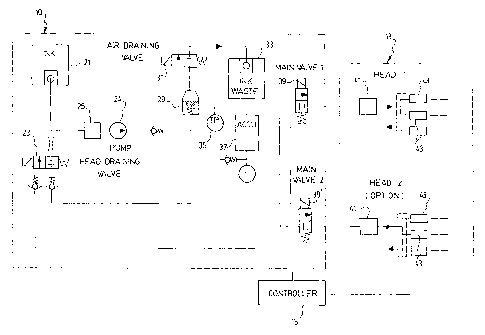Some of the information on this Web page has been provided by external sources. The Government of Canada is not responsible for the accuracy, reliability or currency of the information supplied by external sources. Users wishing to rely upon this information should consult directly with the source of the information. Content provided by external sources is not subject to official languages, privacy and accessibility requirements.
Any discrepancies in the text and image of the Claims and Abstract are due to differing posting times. Text of the Claims and Abstract are posted:
| (12) Patent: | (11) CA 2519245 |
|---|---|
| (54) English Title: | SYSTEM AND METHOD FOR PRINTING A CODE ON AN ELONGATE ARTICLE AND THE CODE SO PRINTED |
| (54) French Title: | SYSTEME ET PROCEDE POUR IMPRIMER UN CODE SUR UN ARTICLE ALLONGE ET CODE AINSI IMPRIME |
| Status: | Expired and beyond the Period of Reversal |
| (51) International Patent Classification (IPC): |
|
|---|---|
| (72) Inventors : |
|
| (73) Owners : |
|
| (71) Applicants : |
|
| (74) Agent: | ROBIC AGENCE PI S.E.C./ROBIC IP AGENCY LP |
| (74) Associate agent: | |
| (45) Issued: | 2008-11-04 |
| (86) PCT Filing Date: | 2004-03-18 |
| (87) Open to Public Inspection: | 2004-09-30 |
| Examination requested: | 2005-09-15 |
| Availability of licence: | N/A |
| Dedicated to the Public: | N/A |
| (25) Language of filing: | English |
| Patent Cooperation Treaty (PCT): | Yes |
|---|---|
| (86) PCT Filing Number: | PCT/CA2004/000423 |
| (87) International Publication Number: | WO 2004082947 |
| (85) National Entry: | 2005-09-15 |
| (30) Application Priority Data: | ||||||
|---|---|---|---|---|---|---|
|
A method and apparatus for printing a redundant code on an elongate article
are disclosed. The apparatus includes an ink unit, at least one printing head
and a controller. The printing head includes two, or three, valves, controlled
by the controller. As the elongate article passes through a printing station,
the controller selectively actuates the valves to release ink, and thus print
the code. The two valves are preferably aligned and laterally spaced from each
other in order to print the same code twice on the article.
Cette invention se rapporte à un procédé et à un appareil permettant d'imprimer un code redondant sur un article allongé. Cet appareil comprend une unité à encre, au moins une tête d'impression et un contrôleur. La tête d'impression comporte deux ou trois valves, commandées par le contrôleur. Lorsque l'article allongé passe à travers une station d'impression, le contrôleur actionne sélectivement les valves pour libérer l'encre et imprimer ainsi le code. Les deux valves sont de préférence alignées et latéralement espacées l'une de l'autre, afin d'imprimer le même code deux fois sur l'article.
Note: Claims are shown in the official language in which they were submitted.
Note: Descriptions are shown in the official language in which they were submitted.

2024-08-01:As part of the Next Generation Patents (NGP) transition, the Canadian Patents Database (CPD) now contains a more detailed Event History, which replicates the Event Log of our new back-office solution.
Please note that "Inactive:" events refers to events no longer in use in our new back-office solution.
For a clearer understanding of the status of the application/patent presented on this page, the site Disclaimer , as well as the definitions for Patent , Event History , Maintenance Fee and Payment History should be consulted.
| Description | Date |
|---|---|
| Time Limit for Reversal Expired | 2012-03-19 |
| Letter Sent | 2011-03-18 |
| Inactive: Correspondence - MF | 2010-08-10 |
| Grant by Issuance | 2008-11-04 |
| Inactive: Cover page published | 2008-11-03 |
| Inactive: Final fee received | 2008-08-15 |
| Pre-grant | 2008-08-15 |
| Notice of Allowance is Issued | 2008-07-22 |
| Letter Sent | 2008-07-22 |
| Notice of Allowance is Issued | 2008-07-22 |
| Inactive: Approved for allowance (AFA) | 2008-05-08 |
| Amendment Received - Voluntary Amendment | 2008-01-31 |
| Inactive: S.30(2) Rules - Examiner requisition | 2007-08-02 |
| Letter Sent | 2006-10-18 |
| Inactive: Single transfer | 2006-09-08 |
| Inactive: Courtesy letter - Evidence | 2005-11-15 |
| Inactive: Cover page published | 2005-11-14 |
| Inactive: Acknowledgment of national entry - RFE | 2005-11-09 |
| Letter Sent | 2005-11-09 |
| Application Received - PCT | 2005-10-25 |
| National Entry Requirements Determined Compliant | 2005-09-15 |
| Request for Examination Requirements Determined Compliant | 2005-09-15 |
| All Requirements for Examination Determined Compliant | 2005-09-15 |
| Application Published (Open to Public Inspection) | 2004-09-30 |
There is no abandonment history.
The last payment was received on 2008-03-03
Note : If the full payment has not been received on or before the date indicated, a further fee may be required which may be one of the following
Please refer to the CIPO Patent Fees web page to see all current fee amounts.
| Fee Type | Anniversary Year | Due Date | Paid Date |
|---|---|---|---|
| Basic national fee - standard | 2005-09-15 | ||
| Request for examination - standard | 2005-09-15 | ||
| MF (application, 2nd anniv.) - standard | 02 | 2006-03-20 | 2006-02-24 |
| Registration of a document | 2006-09-08 | ||
| MF (application, 3rd anniv.) - standard | 03 | 2007-03-19 | 2006-12-28 |
| MF (application, 4th anniv.) - standard | 04 | 2008-03-18 | 2008-03-03 |
| Final fee - standard | 2008-08-15 | ||
| MF (patent, 5th anniv.) - standard | 2009-03-18 | 2009-01-19 | |
| MF (patent, 6th anniv.) - standard | 2010-03-18 | 2010-01-15 |
Note: Records showing the ownership history in alphabetical order.
| Current Owners on Record |
|---|
| AUTOLOG INC. |
| Past Owners on Record |
|---|
| ROBERT LESSARD |